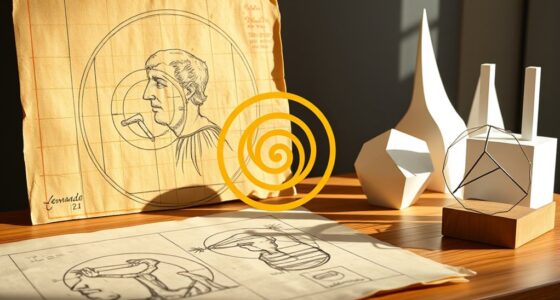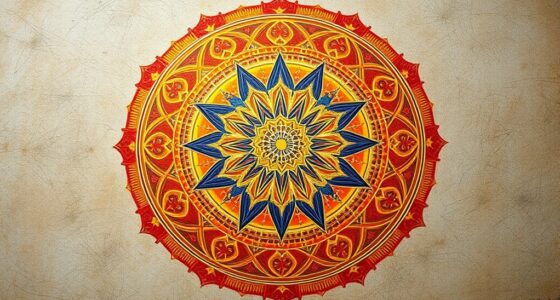Circles, squares, and triangles each hold deep cultural meanings worldwide. Circles often symbolize wholeness, eternity, and unity across many cultures, from Chinese harmony to Native American cycles and Christian eternity. Squares stand for stability, order, and the material world in Western and Asian traditions, often guiding harmony and protection. Triangles represent movement, strength, and spiritual growth, such as pyramids and the Holy Trinity. Exploring these shapes reveals how they mirror core societal values—continue to uncover more insights behind these powerful symbols.
Key Takeaways
- Circles universally symbolize wholeness, eternity, and interconnectedness across diverse cultures, representing concepts like life cycles and spiritual unity.
- Squares and rectangles convey stability, order, and materiality, reflecting societal values of reliability and balance in various traditions.
- Triangles are associated with movement, strength, and hierarchy, often symbolizing spiritual ascent, power, and change across cultures.
- Shape symbolism embodies core cultural values, influencing art, religion, architecture, and societal structures worldwide.
- Understanding geometric symbolism reveals insights into cultural identities, beliefs, and interconnectedness across different societies.

Have you ever wondered how different shapes carry specific meanings across cultures? Geometric symbolism plays a significant role in how societies interpret and assign value to shapes, shaping art, religion, and everyday life. When you look at circles, squares, and triangles, you’re not just seeing simple forms; you’re witnessing symbols that hold deep cultural interpretations. These shapes often embody concepts like unity, stability, or change, depending on the context and culture. Understanding their meanings helps you gain insight into the values and beliefs of different peoples. For example, the environmental impact of these shapes influences how they are used in various cultural artifacts and practices. Starting with circles, they often symbolize wholeness, eternity, and interconnectedness. In many cultures, circles represent life cycles, spiritual unity, or the divine. For example, in Chinese culture, the circle signifies harmony and completeness, reflecting the idea of balance in nature and society. In Native American traditions, circular designs are common in medicine wheels and ceremonies, emphasizing the cyclical nature of life and connection to the earth. Meanwhile, Christian symbolism frequently uses circles to denote eternity, with the endless loop representing God’s eternal nature. These cultural interpretations reveal how the circle’s simplicity masks a complex web of meanings tied to spirituality and unity. Squares and rectangles, on the other hand, often convey stability, order, and the material world. Their geometric symbolism is straightforward: the right angles and equal sides suggest balance and reliability. In Western architecture and art, squares symbolize groundedness and honesty, reflecting human constructs like buildings or city plans that emphasize order. Many Asian cultures associate squares with the earth or the material domain, contrasting with the sky’s fluidity. In Feng Shui, squares represent stability and protection, guiding the placement of objects for harmony. You’ll find that squares appear in religious symbols, flags, and design motifs, underscoring their connection to structure and dependability. Their cultural interpretations often emphasize the importance of stability and security in society. Triangles bring a different set of meanings, often linked to movement, change, or power. Their sharp angles suggest direction and energy. In many societies, triangles symbolize strength and hierarchy. For instance, in Egyptian hieroglyphs, the triangle represents the pyramids and the concept of ascension or spiritual elevation. In Christian iconography, the triangle symbolizes the Holy Trinity, emphasizing divine power and unity. In Asian cultures, triangles can indicate growth or progression, seen in auspicious symbols and patterns. The dynamic nature of triangles makes them versatile in cultural symbolism, representing everything from the elements—fire and water—to spiritual ascent and transformation. As you explore different cultures, you’ll notice how each shape’s geometric symbolism reflects core values, beliefs, and societal structures, making shapes much more than mere visuals—they serve as powerful carriers of cultural meaning.
Frequently Asked Questions
How Do Cultural Interpretations of Shapes Evolve Over Time Globally?
You see how cultural interpretations of shapes evolve through historical reinterpretations and cultural adaptation. As societies change, they reframe symbols like circles, squares, and triangles to reflect new values, beliefs, and identities. This ongoing process allows shapes to carry different meanings across time and regions, influenced by religion, politics, and social shifts. So, your understanding of these symbols deepens as you recognize their dynamic, evolving significance worldwide.
Are Specific Shapes Universally Linked to Particular Emotions?
You might find that specific shapes are often linked to particular emotions through shape perception and emotion association. For example, circles typically evoke feelings of harmony and unity, squares suggest stability and order, while triangles can imply energy or tension. However, these associations aren’t universal; cultural differences influence how you perceive and interpret shapes, meaning your emotional responses can vary based on context and personal experiences.
How Do Indigenous Cultures Incorporate Shape Symbolism in Art?
You see indigenous cultures incorporate shape symbolism into art through traditional motifs that carry deep ritual significance. Circles often symbolize unity or the cycle of life, while triangles might represent spiritual ascent or protection. These shapes are woven into patterns, masks, and ceremonial objects, embodying cultural stories and beliefs. By using these symbols, indigenous artists preserve their heritage and communicate important spiritual and social messages across generations.
What Role Do Shapes Play in Modern Branding Across Different Nations?
Shapes play a vital role in modern branding across different nations by leveraging color psychology and geometric patterns to evoke specific emotions and associations. You notice how circles convey unity and inclusiveness, while squares suggest stability and reliability, and triangles evoke energy and innovation. Brands strategically use these shapes to communicate their values, making their logos memorable and relatable across diverse cultural contexts.
Can Shape Symbolism Influence Architectural Design in Various Cultures?
Shape symbolism definitely influences architectural design across cultures. You’ll notice that shape perception guides choices, reflecting cultural iconography and values. For example, circles can symbolize unity and eternity, while triangles might represent stability or spirituality. When you incorporate these shapes, you’re not just creating structures; you’re embedding cultural meanings into architecture. This approach helps buildings resonate deeply within their communities and convey powerful cultural messages visually.
Conclusion
As you explore the world of shapes, imagine them as the brushstrokes of a grand cultural mosaic, each one whispering stories and beliefs. Circles cradle unity, squares build stability, and triangles reach for the divine. These shapes dance across cultures like timeless melodies, weaving a vibrant tapestry that connects hearts and histories. Embrace their symbolism, and you’ll see how simple forms become powerful symbols, forever shaping the rich, colorful fabric of human expression.









